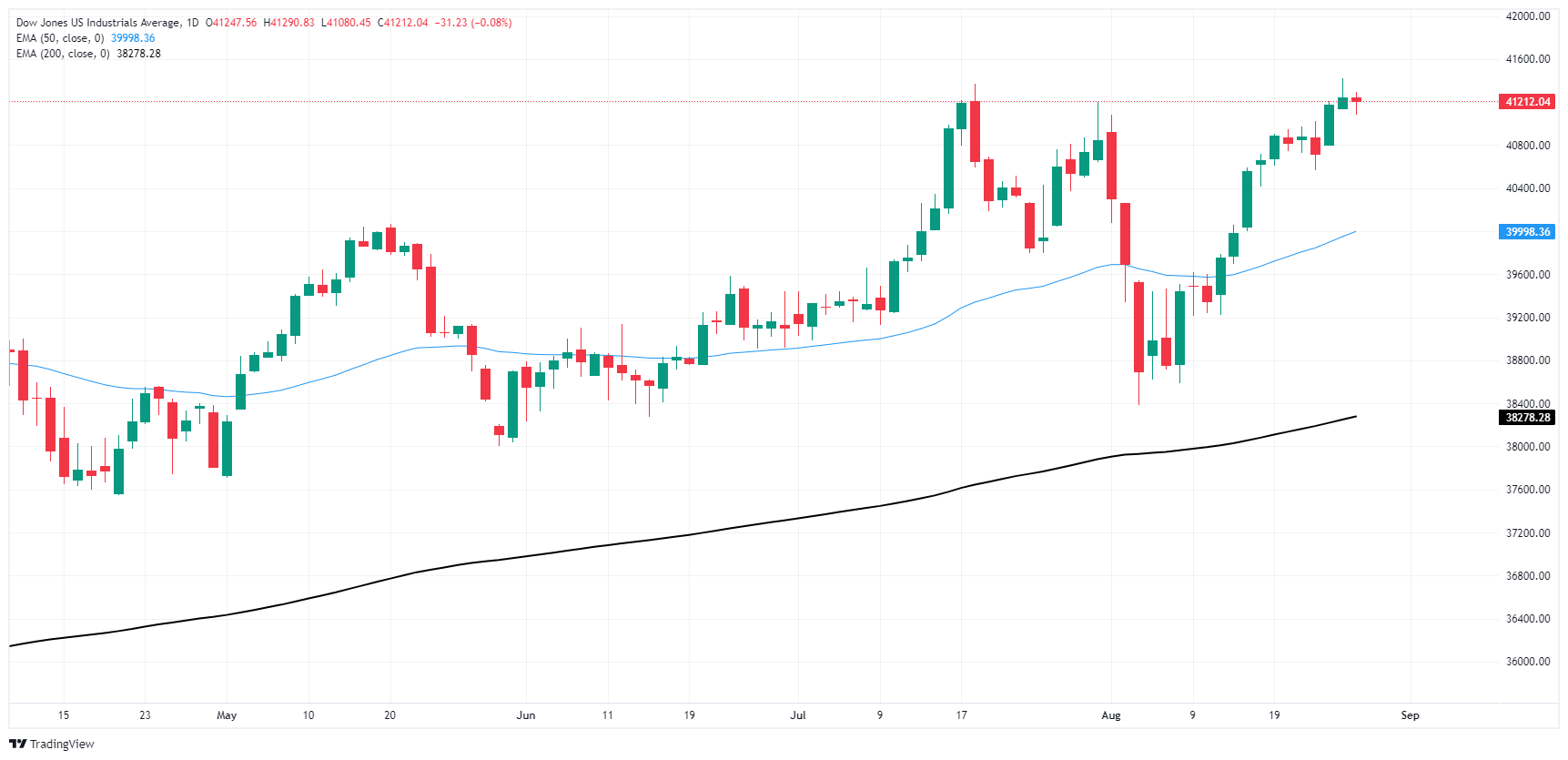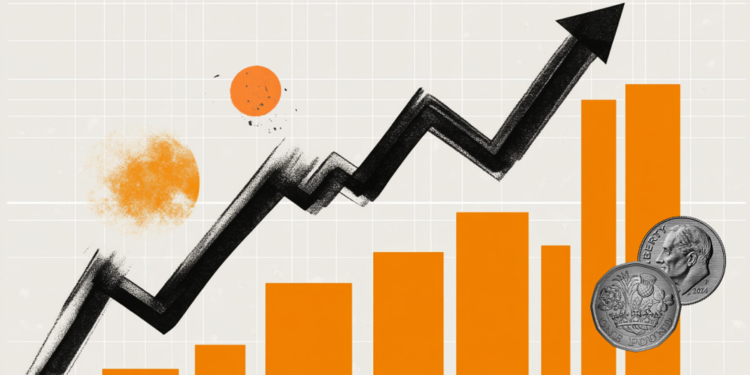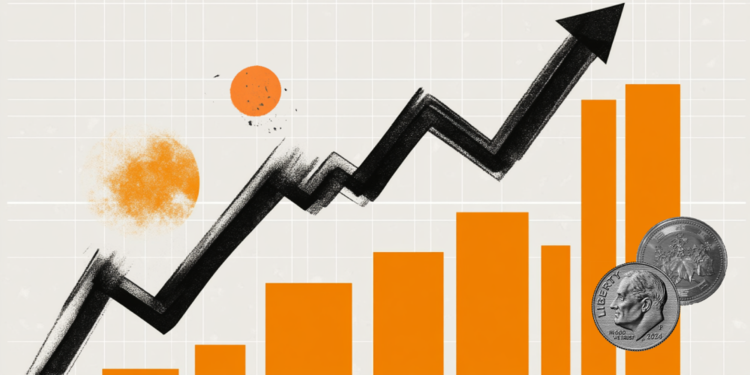- The Dow Jones Industrial Average weakened on Tuesday after hitting new record highs this week.
- Mixed housing figures left markets with little to chew on as traders await rate cuts.
- The release of the US PCE at the end of the week marks a critical reading on inflation.
The Dow Jones Industrial Average (DJIA) weakened on Tuesday after hitting a new all-time high at the start of the trading week. Market action on the Dow Jones has moved towards the middle of the range with market bets of a Federal Reserve (Fed) rate cut in September fully priced in. The long wait until the next Fed rate decision will be filled with debates on whether it will be 25 bps or 50.
Fed Chair Jerome Powell all but confirmed the central bank will pivot to a rate-cutting cycle on Sept. 18 during an appearance at the Jackson Hole economic symposium on Friday, sending market appetite through the roof and setting stocks on a fresh bullish bid.
Mixed figures in the US house price data for June left little for investors. The Federal Housing Finance Agency (FHFA) house price index contracted by -0.1% compared to the May figure of 0.0%. Markets had expected a figure of 0.2%. Meanwhile, the S&P/Case-Shiller house price indexes rose by 6.5% year-on-year, less than the revised 6.9% of the previous period, but still more than the 6.0% expected.
US second-quarter gross domestic product (GDP) figures are scheduled for release on Thursday and are expected to remain flat at an annualised 2.8%. However, the key data release this week will be the US Personal Consumption Expenditure (PCE) Price Index inflation reading for July, which is expected to rise year-on-year to 2.7% from 2.6% and remain flat at 0.2% month-on-month. Market participants, absolutely fired up by rate cut hopes, will be looking for inflation data to come in below expectations, while a higher-than-expected figure could send fresh jitters through investors’ risk appetite.
Dow Jones News
Despite a softer overall tone on Tuesday, the Dow is roughly balanced heading into the middle of the week. Half of the DJIA board is in the green, while the other half is retreating slightly. Nike (NKE) rose 1.1% to $85.20 per share, while Amazon (AMZN) fell 1.08% to $173.61 per share.
Dow Jones Price Forecast
The Dow Jones is trading flat on Tuesday, with some early exploration to the downside. The major stock index tested lower levels but still remains well bid above 41,000.00 and remains near the all-time highs set this week at 41,419.65.
The next immediate hurdle for bidders hoping to re-establish bullish momentum will be a firm break of the 41,500.00 round number barrier. Despite a potential slowdown forming on the daily candles, short sellers will have their work cut out for them trying to drag price action towards the nearest significant technical barrier at the 50-day exponential moving average (EMA) rising towards the 40,000.00 area.
Dow Jones daily chart

The Dow Jones
The Dow Jones Industrial Average, one of the world’s oldest stock market indexes, is made up of the 30 most actively traded stocks in the United States. The index is weighted by price rather than capitalization. It is calculated by adding up the prices of the component securities and dividing by a factor, currently 0.152. The index was founded by Charles Dow, also founder of the Wall Street Journal. In recent years it has been criticized for not being sufficiently representative, as it only tracks 30 companies, unlike broader indexes such as the S&P 500.
There are many factors that drive the Dow Jones Industrial Average (DJIA). The main one is the aggregate performance of the companies that comprise it, as revealed in quarterly corporate earnings reports. US and global macroeconomic data also contribute, as they influence investor confidence. The level of interest rates, set by the Federal Reserve (Fed), also influences the DJIA, as it affects the cost of credit, on which many companies rely heavily. Therefore, inflation can be a determining factor, as well as other parameters that influence the decisions of the Federal Reserve.
Dow Theory is a method for identifying the major trend of the stock market developed by Charles Dow. A key step is to compare the direction of the Dow Jones Industrial Average (DJIA) and the Dow Jones Transportation Average (DJTA) and only follow trends where both move in the same direction. Volume is a confirmation criterion. The theory uses elements of peak-trough analysis. Dow Theory posits three phases of a trend: accumulation, when smart money starts buying or selling; public participation, when the general public joins the trend; and distribution, when smart money leaves the trend.
There are several ways to trade the DJIA. One is to use ETFs that allow investors to trade the DJIA as a single security, rather than having to buy shares of all 30 companies that comprise it. A prominent example is the SPDR Dow Jones Industrial Average ETF (DIA). Futures contracts on the DJIA allow traders to speculate on the future value of the index, and options provide the right, but not the obligation, to buy or sell the index at a predetermined price in the future. Mutual funds allow investors to purchase a portion of a diversified portfolio of DJIA securities, providing exposure to the overall index.
Source: Fx Street
I am Joshua Winder, a senior-level journalist and editor at World Stock Market. I specialize in covering news related to the stock market and economic trends. With more than 8 years of experience in this field, I have become an expert in financial reporting.







